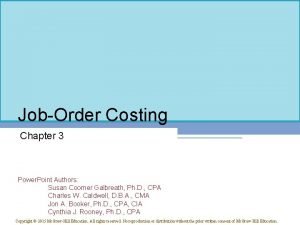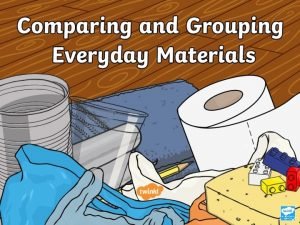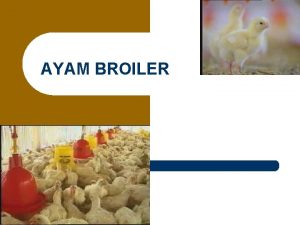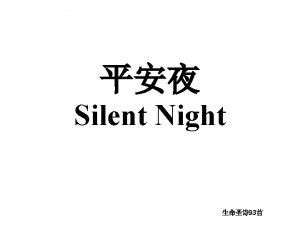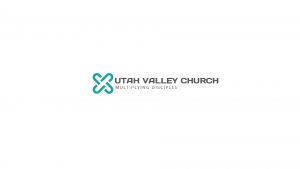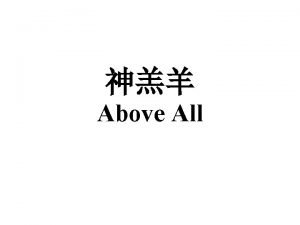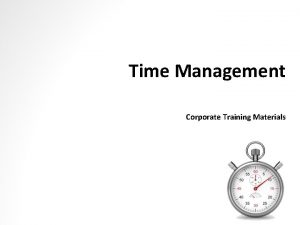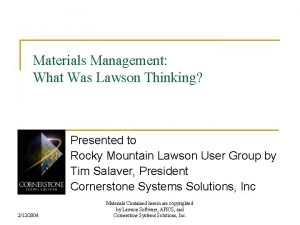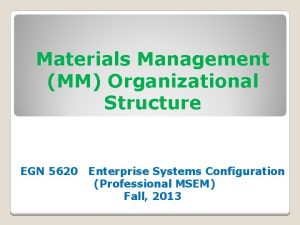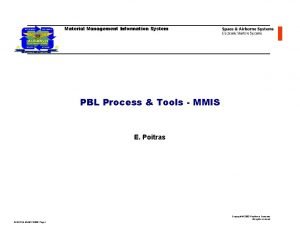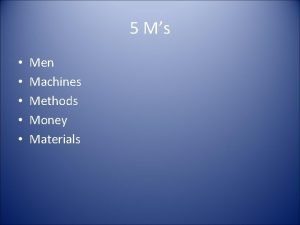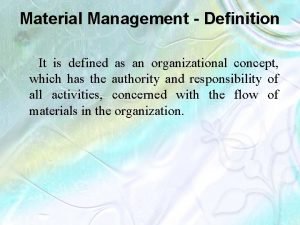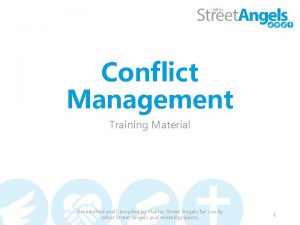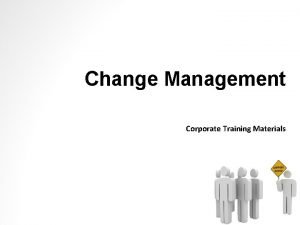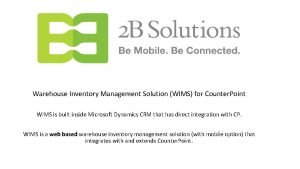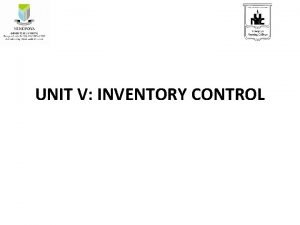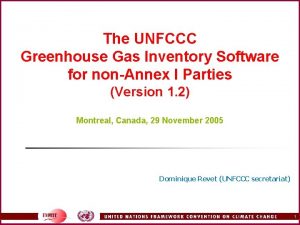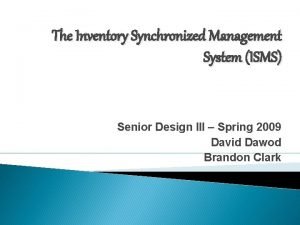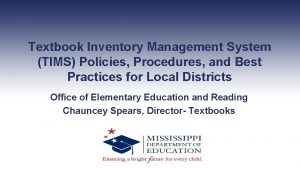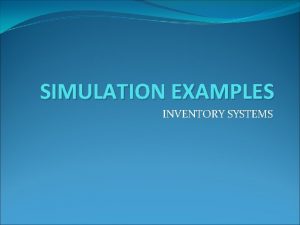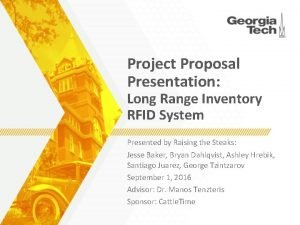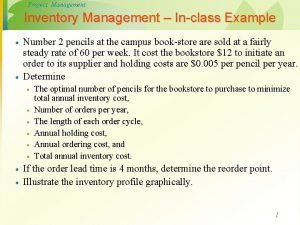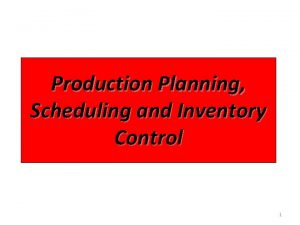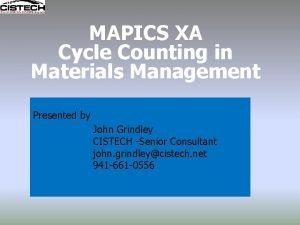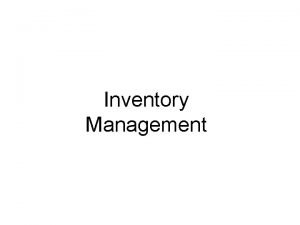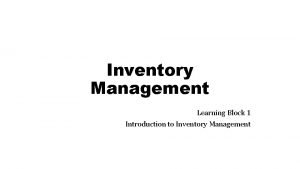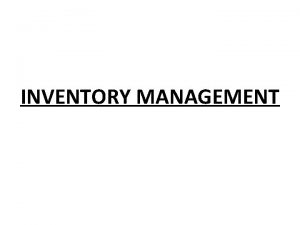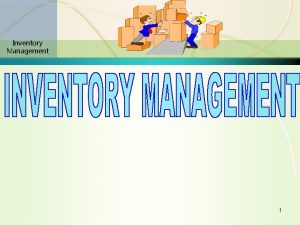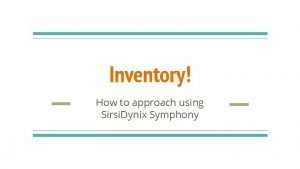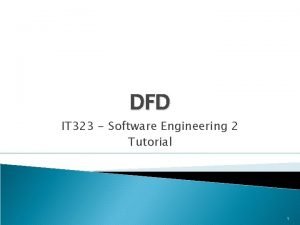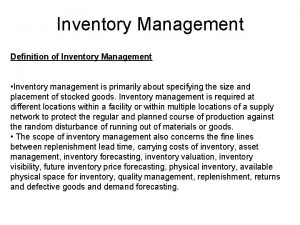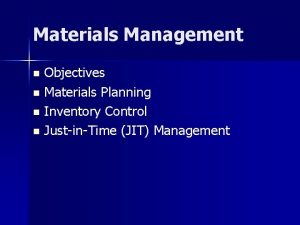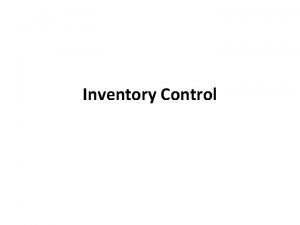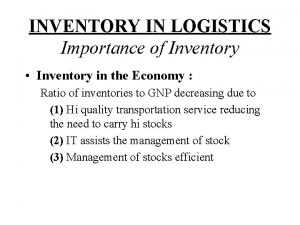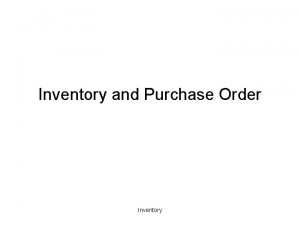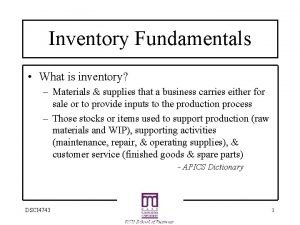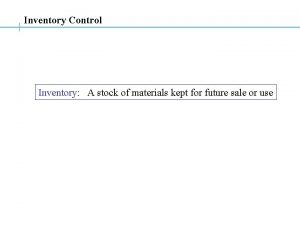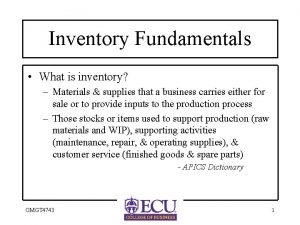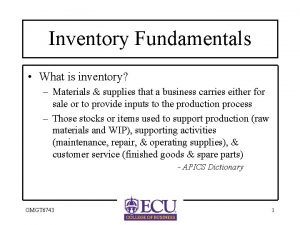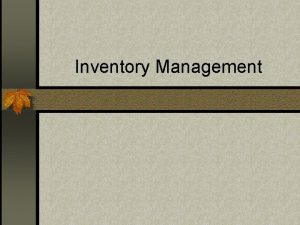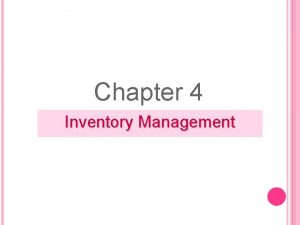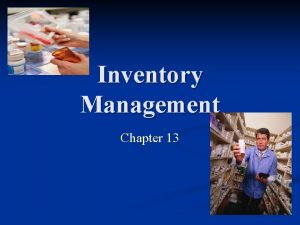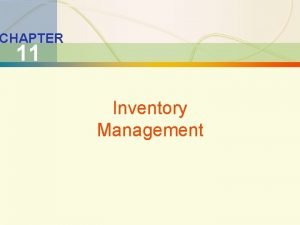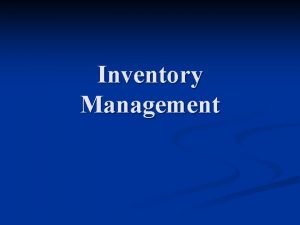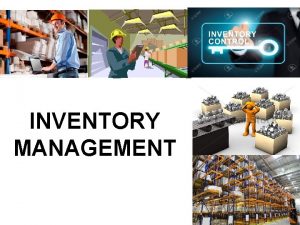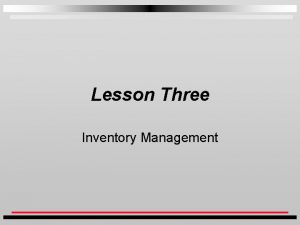11 1 Inventory Management INVENTORY MANAGEMENT All materials


















































- Slides: 50

11 -1 Inventory Management INVENTORY MANAGEMENT All materials parts, expense tools, supplies and in process inventory, finished products maintained in stores is known as Inventory. It is an idle resources that posses economic value. The process of designing / determining systems to exercise control over the inventories is known as Inventory Management.

11 -2 Inventory Management Inventory: a stock or store of goods Dependent Demand A C(2) B(4) D(2) Independent Demand E(1) D(3) F(2) Independent demand is uncertain. Dependent demand is certain.

11 -3 Inventory Management Types of Inventories Raw materials & purchased parts · Partially completed goods called work in progress · · Finished-goods inventories · (manufacturing firms) or merchandise (retail stores)

11 -4 Inventory Management Types of Inventories (Cont’d) · Replacement parts, tools, & supplies · Goods-in-transit to warehouses or customers

11 -5 Inventory Management Functions of Inventory · To meet anticipated demand · To smooth production requirements · To decouple operations · To protect against stock-outs

11 -6 Inventory Management Functions of Inventory (Cont’d) · To take advantage of order cycles · To help hedge against price increases · To permit operations · To take advantage of quantity discounts

11 -7 Inventory Management Objective of Inventory Control · To achieve satisfactory levels of customer service while keeping inventory costs within reasonable bounds · Level of customer service · Costs of ordering and carrying inventory

11 -8 Inventory Management Effective Inventory Management · A system to keep track of inventory · A reliable forecast of demand · Knowledge of lead times · Reasonable estimates of · · Holding costs · Ordering costs · Shortage costs A classification system

11 -9 Inventory Management Questions to be answered in Inevntory Carrying inventory benefits the organisation provided the total costs are minimum for a specified service level. So · How much inventory to order and buy? · When to buy that inventory? ·

11 -10 Inventory Management Key Inventory Terms Lead time: time interval between ordering and receiving the order · Holding (carrying) costs: cost to carry an item in inventory for a length of time, usually a year · Ordering costs: costs of ordering and receiving inventory · Shortage costs: costs when demand exceeds supply ·

11 -11 Inventory Management Inventory Costs Inventory Cost = Carrying Cost + Ordering cost + Cost of the material. TIC= CC + OC + Co. M. Inventory Cost are of Two types: · Costs that encourage to have larger inventory. · Cost that encourage to have smaller inventory.

11 -12 Inventory Management Inventory Costs A balance between the two costs should be done to optimise our investment in inventory. Basically CC increases with increase in Lot size, whereas OC decreases with increase in Lot size. So these costs have to be optimised to determine that Lot size which minimses both the CC and OC and in turn the Total cost of inventory.

11 -13 Inventory Management Cost Minimization Goal Figure 11. 4 C Annual Cost The Total-Cost Curve is U-Shaped Ordering Costs QO (optimal order quantity) Order Quantity (Q)

11 -14 Inventory Management Assumptions of EOQ Model · Only one product is involved · Annual demand requirements known · Demand is even throughout the year · Lead time does not vary · Each order is received in a single delivery · There are no quantity discounts

11 -15 Inventory Management Economic Order Quantity Models · Economic order quantity model · Economic production model · Quantity discount model

11 -16 Inventory Management The Inventory Cycle Figure 11. 2 Q Quantity on hand Profile of Inventory Level Over Time Usage rate Reorder point Receive order Place Receive order Lead time Place Receive order Time

11 -17 Inventory Management Total Costs with Purchasing Cost Annual Purchasing + TC = carrying + ordering cost Q Cc TC = 2 + D Co Q + DC

11 -18 Inventory Management Deriving the EOQ Using calculus, we take the derivative of the total cost function and set the derivative (slope) equal to zero and solve for Q.

11 -19 Inventory Management Minimum Total Cost The total cost curve reaches its minimum where the carrying and ordering costs are equal.

11 -20 Inventory Management Economic Production Quantity (EPQ) Production done in batches or lots · Capacity to produce a part exceeds the part’s usage or demand rate · Assumptions of EPQ are similar to EOQ except orders are received incrementally during production ·

11 -21 Inventory Management Economic Production Quantity Assumptions Only one item is involved · Annual demand is known · Usage rate is constant · Usage occurs continually · Production rate is constant · Lead time does not vary · No quantity discounts ·

11 -22 Inventory Management Economic Run Size

11 -23 Inventory Management Total Costs with Purchasing Cost Annual Purchasing + TC = carrying + ordering cost Q Cc TC = 2 + D Co Q + DC

11 -24 Inventory Management Total Costs with PD Cost Figure 11. 7 Adding Purchasing cost doesn’t change EOQ TC with PD TC without PD PD 0 EOQ Quantity

11 -25 Inventory Management Total Cost with Constant Carrying Costs Figure 11. 9 Total Cost TCa TCb Decreasing Price TCc CC a, b, c OC EOQ Quantity

11 -26 Inventory Management When to Reorder with EOQ Ordering · Reorder Point - When the quantity on hand of an item drops to this amount, the item is reordered · Safety Stock - Stock that is held in excess of expected demand due to variable demand rate and/or lead time. · Service Level - Probability that demand will not exceed supply during lead time.

11 -27 Inventory Management Determinants of the Reorder Point The rate of demand · The lead time · Demand and/or lead time variability · Stockout risk (safety stock) ·

11 -28 Inventory Management The Inventory Cycle Q Quantity on hand Profile of Inventory Level Over Time Usage rate Reorder Point LTD SS Receive order Place Receive order Lead time Place Receive order Time

11 -29 Inventory Management Safety Stock Quantity Figure 11. 12 Maximum probable demand during lead time Expected demand during lead time ROP Safety stock reduces risk of stockout during lead time Safety stock LT Time

11 -30 Inventory Management Reorder Point Figure 11. 13 The ROP based on a normal Distribution of lead time demand Service level Risk of a stockout Probability of no stockout Expected demand 0 ROP Quantity Safety stock z z-scale

11 -31 Inventory Management Fixed-Order-Interval Model Orders are placed at fixed time intervals · Order quantity for next interval? · Suppliers might encourage fixed intervals · May require only periodic checks of inventory levels · Risk of stockout ·

11 -32 Inventory Management Fixed-Interval Benefits Tight control of inventory items · Items from same supplier may yield savings in: · Ordering · Packing · Shipping costs · · May be practical when inventories cannot be closely monitored

11 -33 Inventory Management Fixed-Interval Disadvantages Requires a larger safety stock · Increases carrying cost · Costs of periodic reviews ·

11 -34 Inventory Management Single Period Model · Single period model: model for ordering of perishables and other items with limited useful lives · Shortage cost: generally the unrealized profits per unit · Excess cost: difference between purchase cost and salvage value of items left over at the end of a period

11 -35 Inventory Management Single Period Model · · Continuous stocking levels · Identifies optimal stocking levels · Optimal stocking level balances unit shortage and excess cost Discrete stocking levels · Service levels are discrete rather than continuous · Desired service level is equaled or exceeded

11 -36 Inventory Management Single Period Model Z = Cs Cs + Ce Where Cs = Cost of Shortage Ce = Cost of Excess. Cs = Selling price / unit – Purchase Price / unit Ce = Purchase Price / unit – Salvage value / unit

11 -37 Inventory Management Inventory Control Systems · Periodic Inventory Control System Physical count of items made at periodic intervals · Perpetual Inventory Control System that keeps track of removals from inventory continuously, thus monitoring current levels of each item

11 -38 Inventory Management Inventory Counting Systems · S-s Inventory Control System that keeps track of removals from inventory continuously on a regular interval of time, thus monitoring current levels of each item before placing the order

11 -39 Inventory Management The Inventory Cycle

11 -40 Inventory Management The Inventory Cycle

11 -41 Inventory Management The Inventory Cycle –S-s

11 -42 Inventory Management Inventory Counting Systems (Cont’d) Two-Bin System - Two containers of inventory; reorder when the first is empty · Universal Bar Code - Bar code printed on a label that has information about the item to which it is attached · 0 214800 232087768

11 -43 Inventory Management ABC Classification System Classifying inventory according to the annual value of consumption and allocating control efforts accordingly. A – High Consumption value B – Med. Consumption value High C - low Consumption value. Annual A B $ value of items C Low Few Many Number of Items

11 -44 Inventory Management XYZ Classification System Classifying inventory according to Inventory value on hand allocating control efforts accordingly. X – High inventory value Y - mod. Inventory value Z – low inventory value

11 -45 Inventory Management VED Classification System Classifying inventory according to the criticality of the inventory and allocating control efforts accordingly. V – Vital E - Essential D – Desiable

11 -46 Inventory Management HML Classification System Classifying inventory according to the Unit price of the Inventory and allocating control efforts accordingly. H – High priced M – Medium priced L – Low priced

11 -47 Inventory Management FSN Classification System Classifying inventory according to Issue of materials from stores and allocating control efforts accordingly. F – Fast moving items S - Slow moving items N – Non moving items

11 -48 Inventory Management SOS Classification System Classifying inventory according to the seasonality of the Inventory and allocating control efforts accordingly. S – Seasonal OS – Off Seasonal

11 -49 Inventory Management SDE Classification System Classifying inventory according to the availability of the Inventory and allocating control efforts accordingly. S – Scarce to get D – Difficult to get E – Easily available

11 -50 Inventory Management GOLF Classification System Classifying inventory according to the source of getting the Inventory and allocating control efforts accordingly. GO – Government source L – Local source F – Foreign source
 Name all rays
Name all rays Cant stop the feeling trolls go noodle
Cant stop the feeling trolls go noodle Materials at home that are useful and harmful
Materials at home that are useful and harmful Natural materials and man made materials
Natural materials and man made materials Adopting materials
Adopting materials Direct materials budget with multiple materials
Direct materials budget with multiple materials Raw materials inventory was $27 000
Raw materials inventory was $27 000 Everything around us is called
Everything around us is called Operations management chapter 12 inventory management
Operations management chapter 12 inventory management Love ever hurt never
Love ever hurt never Interventi sociali rivolti alla persona
Interventi sociali rivolti alla persona Crucified laid behind the stone you lived to die
Crucified laid behind the stone you lived to die I work all night
I work all night Communication operations
Communication operations Sistem all in all out
Sistem all in all out Tricep extensiob
Tricep extensiob Silent night holy night all is calm all is bright
Silent night holy night all is calm all is bright 馮定華
馮定華 All of you is more than enough for all of me
All of you is more than enough for all of me She's all states and all princes i nothing else is
She's all states and all princes i nothing else is No power of hell
No power of hell Above all powers
Above all powers Time management training materials
Time management training materials Lawson materials management
Lawson materials management Material management organization structure
Material management organization structure Material management information system
Material management information system 5m money man machine
5m money man machine Institute of supply and materials management
Institute of supply and materials management Certified materials and resource professional (cmrp)
Certified materials and resource professional (cmrp) Function of purchase department
Function of purchase department Defusing conflict palms
Defusing conflict palms Change management training materials
Change management training materials Warehouse inventory management solution (wims) nulled
Warehouse inventory management solution (wims) nulled Inventory meaning
Inventory meaning Greenhouse inventory software
Greenhouse inventory software Conclusion of inventory management
Conclusion of inventory management Inquire
Inquire Inventory simulation examples
Inventory simulation examples 10/6
10/6 Gantt chart inventory system
Gantt chart inventory system Production planning and inventory control
Production planning and inventory control Mapics inventory management
Mapics inventory management Objectives of inventory management
Objectives of inventory management Introduction to inventory
Introduction to inventory Fsn meaning in inventory management
Fsn meaning in inventory management Dependent demand vs independent demand
Dependent demand vs independent demand Independent demand inventory examples
Independent demand inventory examples Introduction of inventory management
Introduction of inventory management Fsn meaning in inventory management
Fsn meaning in inventory management Symphony inventory management
Symphony inventory management Dfd tutorial
Dfd tutorial






